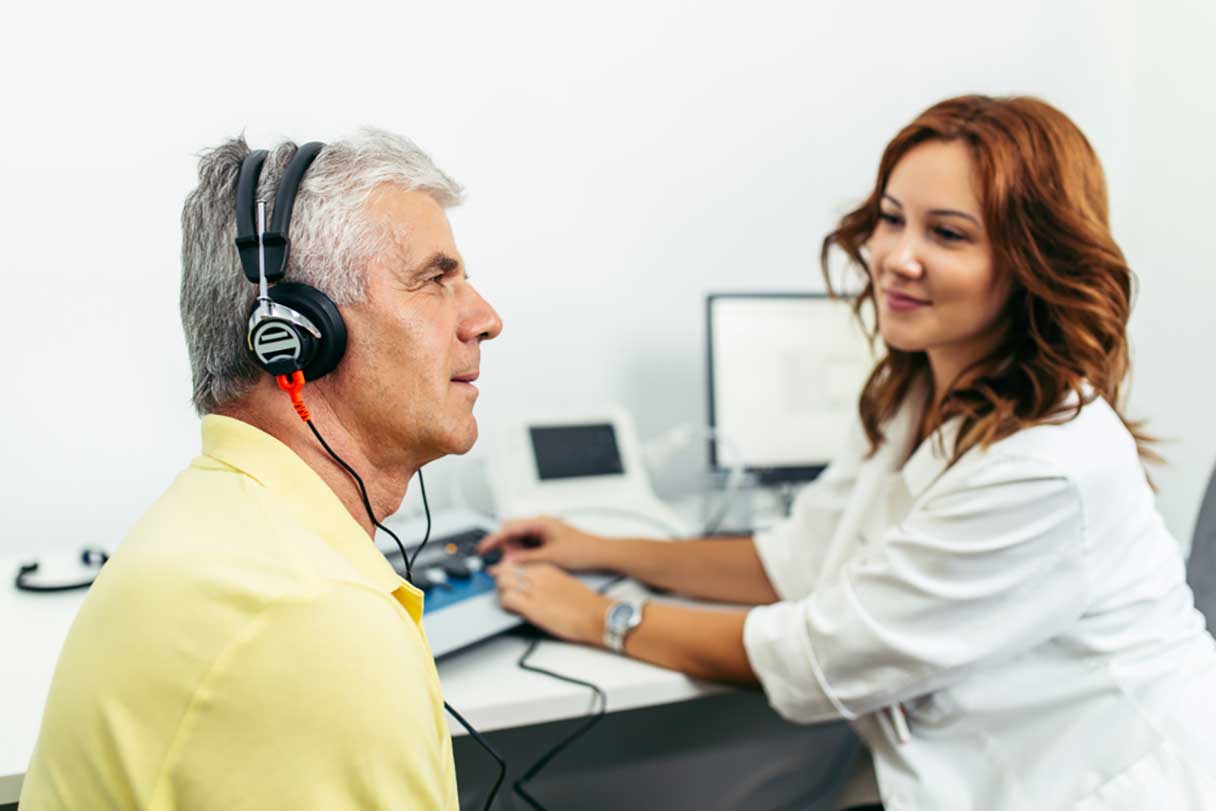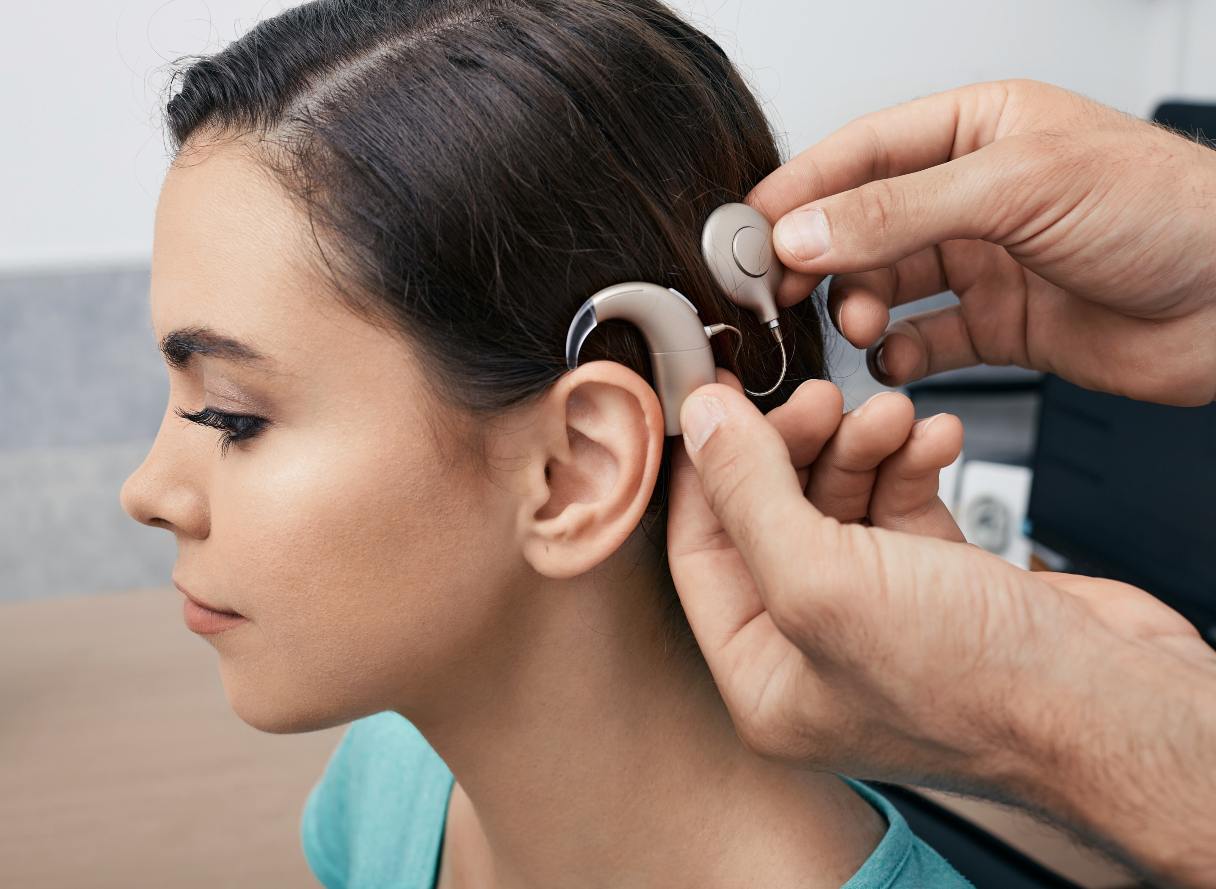Hearing aids are the usual go-to device to treat hearing loss. But did you know that several types of solutions are specifically designed to treat different types of hearing loss?
Hearing aids and cochlear implants both correct hearing loss, but they do so in different ways. Choosing the correct device depends on which part of the ear (outer, middle, inner or auditory nerve) is causing the hearing loss.
What Is a Hearing Aid?
Hearing aids are small devices inserted into your ear that work by amplifying the sound around you, making it easier to hear. Traditional hearing aids are most useful for people with mild to moderate sensorineural hearing loss, which is caused by damage to the inner ear.1
What Is a Cochlear Implant?
Cochlear implants are a more invasive type of hearing aid because they require surgery to insert a small electrode device into your inner ear (cochlea). This device works in tandem with an external transmitter that sits on the outside of your ear, picking up sound from a speech processor attached to a microphone and then sending the signal directly to your auditory nerve.2
Cochlear implants benefit people with severe to profound hearing loss or those who do not get enough support from traditional hearing aids. Both adults and children can get cochlear implants.2
Candidates for Each Device
Good candidates for either a hearing aid or cochlear implant include:
- Hearing aids may be better for people with mild to moderate hearing loss in one or both ears. Hearing aids amplify sound to make it easier to understand speech and to hear in noisy environments.1
- Cochlear implants may be more beneficial for people who are deaf or have severe hearing loss. The U.S. Food and Drug Administration has approved cochlear implants for children as young as 9 months old.2
Advantages and Limitations
The advantages and limitations of hearing aids include:3
| Hearing aid advantages | Hearing aid limitations |
|---|---|
|
|
|
|
|
|
|
|
Hearing aid advantages
The advantages and limitations of cochlear implants include:4
| Hearing aid advantages | Hearing aid limitations |
|---|---|
|
|
|
|
|
|
|
|
|
|
The Process of Getting Hearing Aids
If you are 18 or older, you can now purchase hearing aids over the counter (OTC) at your local pharmacy without a prescription. While this option is convenient, it is still a good idea to work with a doctor to ensure you are using them correctly and that they fit properly.5
Fitting your hearing aids
After you have decided which style of hearing aids will work for your lifestyle, the doctor or a licensed professional will help you with fitting and customizing the hearing aids to your specific needs.6
Getting used to wearing hearing aids can take some time. Your doctor may schedule a few follow-up appointments to ensure everything is working properly.6
The Process of Getting Cochlear Implants
Once you and your doctor have decided that cochlear implants are right for you, a date will be set for your surgery and pre-implant evaluation. During a pre-implant evaluation, your doctor will typically do a variety of things that can include:7
- Comprehensive medical and hearing history
- Meningitis immunization as indicated
- Physical ear, nose and throat (ENT) examination
- Radiological assessment
- Review of surgical procedures and potential complications
Surgical procedure
The surgical procedure involves implanting a small device inside the cochlea, located in the inner ear. It is an outpatient procedure that typically takes about one to three hours. It is done under general anesthesia.7
Activation
After recovering from surgery, the cochlear implant will need to be activated by a licensed professional.7 Activation day can be both exciting and stressful. Family members may be encouraged to participate so they know how to help you.
Rehabilitation
After activation, it is important to participate in rehabilitation that helps you adjust to your new life with cochlear implants.7 This process may take several months and usually begins a few weeks after surgery.
Comparing Costs
Generally, hearing aids are significantly cheaper than cochlear implants. This is due to the surgical requirement and the complexity of getting fitted for cochlear implants.
- Hearing aid pricing. The national average cost* of digital hearing aids is $2,114 per pair, but it can range from $1,650 to $4,155.8
- Cochlear implant pricing. The average cost* of cochlear implants is $51,072, but it can range between $39,475 and $98,195.8
Calculate the cost of a digital hearing aid near you*

Explore procedure costs in your area
Average cost of hearing aids vs. cochlear implants by state/district
Below is a breakdown of the average cost* of digital hearing aids and cochlear implants for all 50 states and the District of Columbia.8
| State/District | Average cost of digital hearing aids (pair) | Average cost of cochlear implant |
|---|---|---|
| Alabama | $1,802 | $43,752 |
| Alaska | $2,558 | $62,393 |
| Arizona | $2,159 | $51,427 |
| Arkansas | $1,836 | $44,519 |
| California | $2,690 | $62,265 |
| Colorado | $2,123 | $52,085 |
| Connecticut | $2,186 | $54,827 |
| Delaware | $2,107 | $51,044 |
| District of Columbia | $2,630 | $63,434 |
| Florida | $2,112 | $51,007 |
| Georgia | $1,924 | $46,493 |
| Hawaii | $3,221 | $74,784 |
| Idaho | $2,164 | $52,195 |
| Illinois | $2,148 | $48,302 |
| Indiana | $1,888 | $46,438 |
| Iowa | $1,811 | $44,629 |
| Kansas | $1,863 | $45,451 |
| Kentucky | $1,940 | $47,041 |
| Louisiana | $1,967 | $47,754 |
| Maine | $2,116 | $51,153 |
| Maryland | $2,399 | $61,077 |
| Massachusetts | $2,508 | $59,597 |
| Michigan | $1,960 | $47,096 |
| Minnesota | $1,953 | $48,247 |
| Mississippi | $1,754 | $42,820 |
| Missouri | $1,867 | $44,903 |
| Montana | $2,057 | $50,331 |
| Nebraska | $1,901 | $45,835 |
| Nevada | $2,105 | $50,550 |
| New Hampshire | $2,250 | $55,210 |
| New Jersey | $2,279 | $55,759 |
| New Mexico | $1,874 | $46,164 |
| New York | $2,318 | $55,649 |
| North Carolina | $1,928 | $47,644 |
| North Dakota | $1,935 | $46,877 |
| Ohio | $1,944 | $48,357 |
| Oklahoma | $1,840 | $43,423 |
| Oregon | $2,234 | $55,375 |
| Pennsylvania | $2,071 | $49,837 |
| Rhode Island | $2,177 | $54,827 |
| South Carolina | $1,978 | $47,973 |
| South Dakota | $1,917 | $47,206 |
| Tennessee | $1,840 | $45,945 |
| Texas | $1,985 | $47,261 |
| Utah | $2,125 | $51,702 |
| Vermont | $2,245 | $52,798 |
| Virginia | $2,069 | $50,112 |
| Washington | $2,331 | $54,936 |
| West Virginia | $1,872 | $44,793 |
| Wisconsin | $1,974 | $47,535 |
| Wyoming | $1,985 | $49,234 |
Insurance Coverage
- Hearing aids insurance coverage varies by state. Traditional Medicare doesn’t offer much assistance for adults; Medicaid does cover hearing aids for children. Supplemental or private insurance may cover the cost of hearing aids, depending on your specific healthcare plan.9
- Cochlear implants are typically covered by health insurance. This includes Medicare, Medicaid and most commercial healthcare plans.10
Living With the Device
Adjusting to life with a hearing device can take time, but the positive outcome can help boost your quality of life.1
Daily life with hearing aids
Keep these things in mind as you adjust to your daily life with hearing aids:5
- Attend follow-up appointments with your doctor to ensure the hearing aids are working correctly.
- Be patient while your brain adjusts to the new sounds.
- Have extra batteries on hand in case you need to replace them.
- Make sure to routinely maintain and care for your hearing aids.
- Wear them consistently for maximum impact.
Daily life with a cochlear implant
Here are some things to consider in your daily life while wearing cochlear implants:
- Attend follow-up appointments with your doctor and rehabilitation specialist.7
- Be patient during your initial adjustment.
- Enjoy being able to hear sounds you couldn’t before.
- Enjoy music, talking on the phone and other social activities.
- Routinely maintain and care for the sound processor.
- Use rehabilitation resources to practice your new skills.7
What to Remember When Deciding
Living with hearing loss can be challenging and stressful, but there are many options available to help improve your quality of life. The decision between getting a hearing aid and a cochlear implant will depend on the type and severity of your hearing loss, as well as your budget.
Regardless of the device you choose, it is recommended that you consult with a doctor or licensed healthcare professional who can help you make the right decision. Once you have been fitted with your new device, be sure to attend all follow-up appointments and regularly clean and maintain your device to ensure optimal hearing.
Frequently Asked Questions
Still have questions about hearing aids and cochlear implants? Here are answers to some commonly asked questions about them.
Financing Ear Care With the CareCredit Card
The CareCredit credit card can help you pay for hearing care, including regular hearing tests, screenings and more.** Use our Acceptance Locator to find a hearing specialist near you that accepts CareCredit. Continue to invest in your wellness journey by downloading the CareCredit Mobile App to manage your account, find a provider on the go and easily access the Well U blog for more great articles, podcasts and videos.
In addition to hearing care, you can also use your CareCredit credit card for dentistry, cosmetic, pet care, vision, health systems, dermatology, pharmacy purchases, spa treatments and so much more within the CareCredit network. How will you invest in your health and wellness next?
Author Bio
Amy Isler, M.S.N., R.N., has more than a decade of nursing expertise. She combines her nursing experience and journalism background to create engaging and educational healthcare content for leading brands and publications, including GoodRx, Verywell Health, Vision Center and more. Her mission in writing is to provide positive, accurate and informative articles for consumers.







